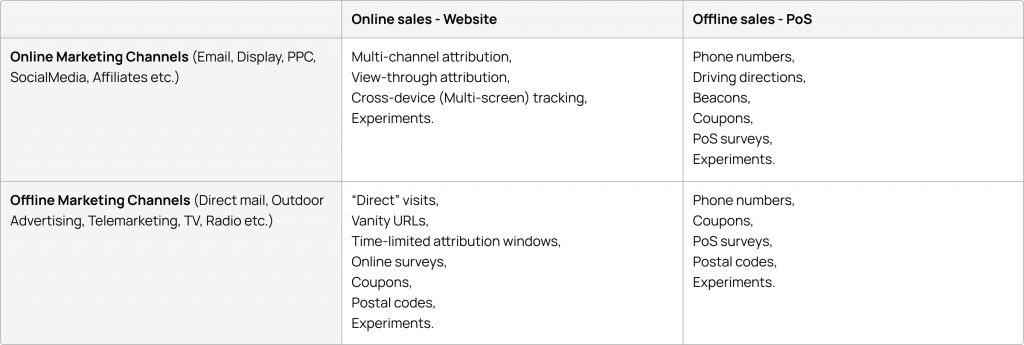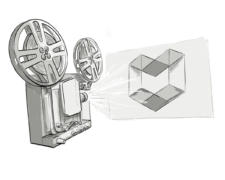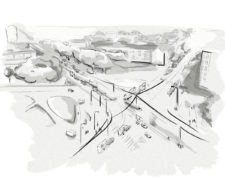Over the past few years, marketers have become crazy about multi-channel attribution models. These models help them understand the kind of impact each online marketing channel (social, display, paid search traffic etc.) has on online sales, how effective campaigns are, and how the channels interact with each other. They also help attribute revenue to each channel and calculate return on investment (ROI), which is an essential indicator on how to justify and (re)allocate future media budgets.
There is, however, one main problem that exists: multi-channel attribution does not take into account both offline sales and offline marketing.
So in other words, it will work perfectly in the case of an online-only business using online-only marketing channels, but in reality, such businesses are in the minority.
As an example, let’s look at retail: In 2013, e-commerce accounted for 5.8% of total sales – $263.30 billion was spent in online stores, but think about the remaining 94.2%!(1).
What’s more, online presence drives more revenue offline than online. It is predicted that by 2017, more than half of all U.S. retail sales will be influenced by the web in some way (Forrester Research Inc. report, “U.S. Cross-Channel Retail Forecast, 2012 To 2017”), so there is a huge opportunity for underserved marketers who can use the data to improve their ROI on marketing budgets.
Attribution techniques
In this article, I would like to focus on attribution techniques in the following three areas:
- Online Marketing Channel to Offline Conversion attribution
- Offline Marketing Channel to Online Conversion attribution
- Offline Marketing Channel to Offline Conversion attribution
We will not be covering Online to Online, as this is a very vast topic that deserves another article – so stay tuned!
Let’s start with a quick list and summary presented in the table below:

How Do I Measure the Impact of an Offline Marketing Campaign Based on Online Activity?
‘Direct’ Visits Attribution
We may be tempted to look at “direct”* website-traffic conversions and assume these visits were influenced by the campaign, but this could be very, very wrong.
(*) “Direct” traffic is a common term for traffic without a referrer; that is, not coming from search engines, social media, other websites, or UTM-tagged online campaigns.
There may be various invalid “direct” traffic sources for such attribution:
- Existing customers who bookmarked your website or typed the URL in the browser,
- Non-tagged campaign traffic (i.e. email, mobile apps including social – in general, where the referrer is not passed or hidden),
- Traffic with lost referrer information (i.e. redirects HTTP->HTTPS or HTTPS->HTTP do not carry the referrer),
- A web-analytics tag that did not execute on the landing (first) page, due to either performance (page overloaded with tags) or an error (missing tag or syntax error that stopped execution).
In contrast to online information, it is much harder to collect and attribute data offline.
So let’s find something better!
Vanity URLs
Vanity URLs are unique domain names, such asbmyproduct.com or mybrand.com/product, that are used in advertisements like print ads and TV commercials. Once entered into the browser, a vanity URL will redirect the user to the destination page and add parameters (UTM tags) for traffic attribution.
It is certainly an improvement compared to “direct” traffic attribution, however it still may not be accurate because many users will just type the brand name into a search engine to find the website. Most modern browsers are integrated with search engines that encourage users to do just that instead of typing the full URL.
The number of visits may be lower than the actual number of users who were genuinely influenced by the campaign, but at least they will be all valid respondents.
Time-limited attribution windows
When a marketing campaign has a specific airing time (i.e. TV, radio campaigns), we can attribute the difference in traffic/conversions compared to a similar period in the time before (our baseline).
There are a few questions that arise immediately:
- How many minutes/hours after the airing time shall we still attribute the difference?
- What are the best techniques we can use to weed out visitors who were not exposed to the campaign?
- When do we need to worry about the impact of other campaigns?
This can become a complex process and it is beyond the capabilities of standard web-analytics packages.
Online surveys
What if instead of using complex models and techniques, we simply ask the customer how they learned about our website? This is a very simple, but powerful technique for tracking the effectiveness of various marketing channels. Not every user will fill it out (or they may just select a random field if you make it required at the sign-up/purchase stage), but it should still be enough to contrast the data with other techniques and learn more about other non-marketing sources (such as referrals, which are much more powerful than any other marketing channel).
You can implement online surveys at four different levels:
- When a user fills out the purchase/sign-up form.
- When a user is browsing your website, open a discrete bar/pop-up asking them to fill out a survey (you could offer a coupon code as a reward).
- When the user is leaving the website, open a survey.
- When customers interact with your social media content or ads, provide a QR code survey for convenient feedback and valuable insights to fuel your business’s growth.
The first option will allow you to track the Customer Lifetime Value (CLV) for a given marketing channel, but it is limited to the visitors who converted (i.e. made a purchase or signed up). The other two also allow us to capture and attribute visits to the website that did not convert (and may be used later for multi-channel attribution).
How to combine offline and online data?
Coupons
Coupons are a reasonable and effective way to get a direct response from a marketing campaign. They also offer a mutual benefit to marketers and potential clients. The first can measure precisely how many direct responses the campaign(s) receives, and the other gets more for a lower price.
Marketers can issue coupons and send them out via all channels (it’s wise to issue unique coupons per campaign, and when possible, per client).
By tracking the coupons’ redemption, we can easily see how many online (or offline) sales were made using a given coupon code and tie the conversions (revenue) to a given marketing channel.
Similarly, loyalty cards are an even more powerful tool in the hands of marketers, as they tie together all the offline and online sales of a single customer. However, their use is limited to an existing customer base, rather than customer acquisition.
Postal codes
Postal codes can be used in various ways for offline campaign attribution. Let’s start with the data collection.
Marketers can easily collect postal codes at POS at checkout counters (very annoying, but still effective). As for e-commerce, we can track the delivery postal code or billing postal code (both may be applicable).
Having the postal code and associated transactions, we can use this data in various ways to measure the effectiveness of:
- Direct-mail campaigns or leaflet distribution in a given postal code area,
- Display and PPC online campaigns targeted at a given postal code.
With POS, it’s important to track the number of visitors. Our marketing campaign may be effective (an increase in the number of people reaching our POS stage), but they may not purchase items due to other reasons (e.g. out of stock).
How Do I Attribute an Online Campaign to an Offline (POS) Transaction?
Driving Directions
Let’s start with simple ideas. What about tracking the number of visitors who used the driving directions or store-locator feature on the website?
We can easily track the number of visitors per channel who used this feature and, hence, are likely to visit and possibly make a purchase (the value at the POS can be an average transaction value on that day/in a month).
POS surveys
Another simple technique, which is similar to online surveys, is to ask the clients survey questions at the POS. The survey may measure both the impact of different channels (where the customer saw your ad) as well as various other aspects which are not relevant to marketing-channel attribution, but may be very important for the business (e.g. customer satisfaction).
Beacons
Beacons are low-energy Bluetooth devices that a customer may interact with when using an app on a smartphone. It’s a very hot, widely discussed technology that emerged in 2013 (you can learn more about them here).
In a nutshell, marketers can engage customers by interacting with their smartphones at the POS with beacons located throughout the store. The point of this is to deliver a better customer experience… but also to track the customers.
If a customer downloaded the beacon app as a result of an email or online campaign, we will be able to easily attribute their visit from the POS to that campaign. We might also be able to do much more, but to learn more, we might need to wait until the technology becomes more widely adopted.
Running Experiments
Unfortunately, there is some bad news I need to share.
Getting meaningful data isn’t easy and it won’t be enough to use the above-mentioned techniques without diving deeper into statistical analysis and running some experiments.
To do so, your knowledge of statistical analysis will need to be quite good and you’ll probably need to develop some tools on top of the existing data stores so that you’re able to get what you want.
The good news is that there are various interesting startups working on addressing these needs – the market does not like to be underserved for too long!
It’s easy to see why the combination of online and offline attribution is the wave of the future for marketers. Although it’s quite a young area in the analytics field, it is starting to gain traction. The relationship between the online and offline activity of users is one that will be closely looked at and explored over the next few years. Watch this space!
Here at Clearcode, we build scalable and innovative RTB and Ad Tech platforms for the programmatic advertising industry. Click here to learn more about how we can help you with your next ad tech project.







